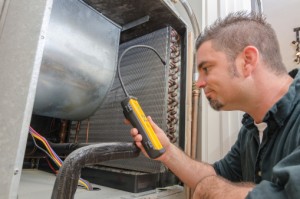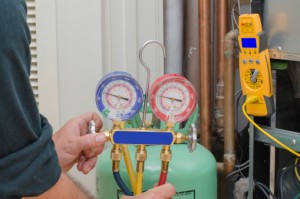Learn More About Refrigerant Changes
It used to be a fairly inexpensive fix to charge your air conditioning system with Freon®, or R-22, refrigerant. Just a few pounds of the refrigerant, and your unit would make it through yet another sweltering summer. R-22 was plentiful, and that made it easy for us to recharge your system and get you up and running again. But, the days of low-cost recharge repairs are going by the wayside. Most air conditioning systems more than five years old use R-22 refrigerant – and it’s being phased out.
The reason for this is because R-22 refrigerant contains chlorofluorocarbons, or CFCs. The Environmental Protection Agency has targeted products containing CFCs for phase-out, because they have been found to cause damage to the earth’s ozone layer. Each year, the availability of R-22 for air conditioning repair becomes more and more scarce, and by 2020, there will be no new R-22 on the market. Following the laws of supply and demand, it becomes pretty clear that R-22 is becoming a costly commodity.
What does this mean for T.F. O’Brien as an air conditioning contractor, and for me as a consumer?
 The bottom line is, the government doesn’t want consumers or contractors to use R-22. Prices for the refrigerant have increased upwards of 200-300 percent since 2010, and they’re only expected to keep increasing. Part of the EPA’s strategy is to encourage homeowners to repair leaks or replace systems rather than continue to add more R-22 refrigerant. Making it costly to continue to pump R-22 into a leaky system – and into the environment – is one way the EPA is encouraging a conversion to newer equipment.
The bottom line is, the government doesn’t want consumers or contractors to use R-22. Prices for the refrigerant have increased upwards of 200-300 percent since 2010, and they’re only expected to keep increasing. Part of the EPA’s strategy is to encourage homeowners to repair leaks or replace systems rather than continue to add more R-22 refrigerant. Making it costly to continue to pump R-22 into a leaky system – and into the environment – is one way the EPA is encouraging a conversion to newer equipment.
So, the EPA is just trying to make consumers purchase new systems?
 In a nutshell – yes. But this isn’t necessarily a bad thing, for you or for the environment. New air-conditioning systems use R-410A, which is more environmentally friendly than R-22 and doesn’t deplete the ozone layer. Not to mention, new air conditioning systems have improved by leaps and bounds when it comes to energy efficiency – even the lowest efficiency systems of today use significantly less energy than the best models used just a few years ago. Depending on the age and condition of your current system, you could be looking at a savings on your utility bills that nearly covers the cost of your payments on a new system.
In a nutshell – yes. But this isn’t necessarily a bad thing, for you or for the environment. New air-conditioning systems use R-410A, which is more environmentally friendly than R-22 and doesn’t deplete the ozone layer. Not to mention, new air conditioning systems have improved by leaps and bounds when it comes to energy efficiency – even the lowest efficiency systems of today use significantly less energy than the best models used just a few years ago. Depending on the age and condition of your current system, you could be looking at a savings on your utility bills that nearly covers the cost of your payments on a new system.
Why not just recharge my system with R-410A then?
 Simply put, you can’t. These two refrigerants are not compatible and should never be mixed. All the parts inside new systems have been engineered to function with R-410A refrigerant, and use different pressures, configurations, coil sizes and types of metal. Adding R-410A to an old system can be dangerous, and at the very least would completely ruin your air conditioner.
Simply put, you can’t. These two refrigerants are not compatible and should never be mixed. All the parts inside new systems have been engineered to function with R-410A refrigerant, and use different pressures, configurations, coil sizes and types of metal. Adding R-410A to an old system can be dangerous, and at the very least would completely ruin your air conditioner.
How can T.F. O’Brien help me?

We want you to know we’re professionals, and it’s a fine line for us to give our customers the best possible repair services and replacement options, given the changing government mandates and the expense of materials. The fact is, your air conditioning system, especially if it’s an older one, is going to break down eventually, no matter how well you maintain it. A new home comfort system is not something that’s necessarily exciting, like a new car or boat, but it is something you use daily and rely on. We just want to make sure you know you can trust us to provide you with the best system on the market today – and one that is compatible with government regulations and energy guidelines.
If you’d like to know more about the R-22 phase-out, visit the EPA online by clicking here.
